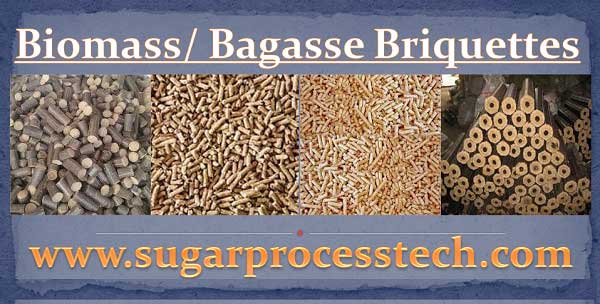This session explained about the meaning of biomass/ bagasse briquettes, the manufacturing process of briquettes, the Application of Biomass briquettes, and approximate Calorific values of Biomass Briquettes.
Biomass Briquettes Manufacturing Process | How to Make Bagasse Briquettes
Bagasse Briquettes Meaning
Bagasse briquettes are made from sugar cane bagasse ( one of the major product in the cane sugar manufacturing process). Biomass or bagasse briquettes is the process of converting low-density biomass into high-density fuel briquettes. These bagasse briquettes are renewable in energy.
Bagasse/Biomass Briquettes are the best fuel because it is Environment Friendly & cheap compared to other fuels.
Bagasse briquettes and pellets have high calorific values, low ash content, and low moisture content.
For high-quality bagasse briquettes, the moisture content of bagasse should be less than 12%
Sugar cane bagasse briquettes calorific value is 4200 Kcal/kg
Manufacturing Process of Bagasse or Biomass Briquettes
1 . Raw material ( Biomass or bagasse ) size required 10 mm to 25 mm.
2. Raw material moisture content shall be maintained at 10% to 12%. So use a drier to dry the bagasse before feeding it to briquetting machine.
3. The dried biomass or bagasse is fed to the feed box is compressed by the press, forcing it through the tapper die(ram punch) fitted in the Die Holder.
4. The compression raises the temperature of the material which results in softening of the Lignin. Every biomass inherently has lignin content. Due to this the surface of briquettes comes softening and binds the material together. So no need to add any chemicals or adhesive or binder technology.
5. Provided pressures of the order to a minimum 350 kg/cm2 are used, or preferably 1000 kg/cm2
6. Biomass briquettes formed are in the shape of cylindrical logs which are pushed through cooling tracks under slight pressure for cooling and then to transport the storage point.
7. Cooled briquettes are broken and packed in bags or stored in bulk for dispatch.
Major Equipment Used in Biomass/Bagasse briquettes.
a) Briquetting Press
b) Load wheel
c) Feeding Cup
d) Reduction Gear
e) Screw Conveyor
f) Main electric motor
g) Flat belt
h) Die holder
i) cooling track
Why bagasse /Biomass Briquettes are preferred
1. Biomass briquettes are renewable energy fuels.
2. It has high burning efficiency.
3. Bagasse briquettes not having any sulfur material. So it is Pollution free fuel
4. It is the best substitute source of energy.
5. Biomass briquettes have a higher practical thermal value.
6. Higher fixed carbon value and lower ash content (2 to 6 %) compare to coal
7. Using briquettes will be beneficial for the industries as (20 to 25%). they will get carbon credit.
8. Fly ash content is very low when burning briquettes.
9. Briquettes contain low moisture (3 to 6%) compare to other fuels like coal.
Application of Biomass briquettes
1. Brick-making units
2. Ceramic Industries
3. Chemical Industries
4. Milk Plant
5. Vegetable plants
6. Spinning mills
7. Leather industries.
8. Rubber Industries.
9. Solvent Extraction Industries.
10. Food processing Industries.
11. Dyeing units.
12. Textile units.
13. Lamination Industries.
Approximate Calorific values Biomass Briquettes of different types of raw materials
Bamboo Dust : 4160 Kcal/kg
Cotton Stalk : 3800 Kcal/kg
Coir Pitch : 4146 Kcal/kg
Coffee Husk : 4200 Kcal/kg
Castor Seed Shell : 3860 Kcal/kg
Forestry waste : 3000 Kcal/kg
Ground Nut Shell : 4000 Kcal/kg
Jute Waste : 4428 Kcal/kg
Mustard Husk : 4500 Kcal/kg
Maize Stalks : 3800 Kcal/kg
Paddy straw : 3469 Kcal/kg
Palm husk : 3900 Kcal/kg
Rice Husk : 3200 Kcal/kg
Rice Straw : 3500 Kcal/kg
Sugar cane Bagasse : 4200 Kcal/kg
Sugar Cane Trash : 3500 Kcal/kg
Saw dust briquette : 3898 Kcal/kg
Soya bean husk : 4170 Kcal/kg
Sunflower stalk : 4300 Kcal/kg
Tea waste : 4237 Kcal/kg
Tobacco waste : 2910 Kcal/kg
Wood chips : 4785 Kcal/kg
Wheat Straw : 3700 Kcal/kg
Thank you for reading this article “ Bagasse / Biomass Briquettes Manufacturing Process”. We hope that this article was full filled your requirement. Give feedback, comments and please share it.
Related Articles:
Raw Sugar Making Process | Raw Sugar specifications.
Brown Sugar manufacturing process | Specifications of brown sugar
Specialty sugar products Like Cube sugar | Fondant sugars | Candy sugar
Liquid Sugar Manufacturing Process from sugar cane
Methods for Industrial Effluent Treatment Plant (ETP)
Pump Power Calculation Formula | Specific speed of a centrifugal pump
Static Suction Head Calculation of pump | Pressure Head | Velocity head
Pump Affinity Laws for Centrifugal and Positive displacement pumps

6 thoughts on “Bagasse Briquettes Manufacturing process | How to Make Biomass Briquettes”
Nagaraj .v
(June 5, 2019 - 6:49 pm)Thanks sir best knowledge
siva alluri
(June 6, 2019 - 3:49 pm)Thank you sir
Chandrasekhar
(June 9, 2019 - 3:44 am)Helpful
siva alluri
(June 9, 2019 - 1:45 pm)Thank you
Mangesh potadar
(December 10, 2019 - 9:35 pm)Sir.how much molasses quantity used in bagasse Briquettes manufacturing process
Ca.H.P.Daga
(July 27, 2022 - 10:31 am)Pl inform me whether it is a product ,agrobased ? I think it is. So eligible for incentive.